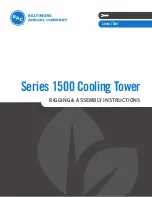
835961-UIM-D-0213
6
Johnson Controls Unitary Products
SECTION VI: EVACUATION
It will be necessary to evacuate the system to 500 microns or less. If a
leak is suspected, leak test with dry nitrogen to locate the leak. Repair
the leak and test again.
To verify that the system has no leaks, simply close the valve to the vac-
uum pump suction to isolate the pump and hold the system under vac-
uum. Watch the micron gauge for a few minutes. If the micron gauge
indicates a steady and continuous rise, it’s an indication of a leak. If the
gauge shows a rise, then levels off after a few minutes and remains
fairly constant, its an indication that the system is leak free but still con-
tains moisture and may require further evacuation if the reading is
above 500 microns.
SECTION VII: SYSTEM CHARGE
To ensure that your unit performs at the published levels, it is important
that the indoor airflow is determined and refrigerant charge added
accordingly.
Measure Indoor Air Flow:
To determine rated air flow for a specific match, consult the technical lit-
erature at www.upgnet.com.
Examples:
GHGD1 AHE18B3XH21 = 610 CFM
THGF FC35B3XN1 = 800 CFM
THJR3 AHV36C3XH21 = 940 CFM
YHJD4 FC60 TM9X100C20MP11A = 1625 CFM.
THGF6 MC6 MV20DN21C = 1855 CFM(High) & 1160 (Low)
When attempting to match this air flow, select the lowest possible speed
tap and measure the actual flow and adjust as necessary. Checking
jumper pin setting tables is not an acceptable method for determining
air flow. To determine indoor air flow, first measure the static pressure
with a manometer between the filter and blower. On a single-piece air
handler, take a second reading after the coil. On a furnace or modular
air handler, take the second reading after the heat exchanger, but
before the indoor coil. Add the negative return static to the positive sup-
ply static to determine the system total static pressure. Treat the nega-
tive return static as a positive pressure as even though it is a negative
reading, it is static pressure on the blower; i.e. -.10 return static added
to a .40 supply static equals a .50 total system static pressure. Compare
this value the indoor unit's static pressure chart vs. CFM table or curve.
Charging the Unit:
The factory charge in the outdoor unit includes enough charge for the
unit, a 15 ft. (4.6 m) line set, and the smallest indoor coil/air handler
match-up. Some indoor coil/air handler matches may require additional
charge. See Tabular Data Sheet provided in unit Customer Booklet for
charge requirements.
The "TOTAL SYSTEM CHARGE" must be permanently marked on the
unit data plate.
Total system charge is determined as follows:
1. Determine outdoor unit factory charge from Tabular Data Sheet.
2. Determine indoor coil adjustment (if any) from Tabular Data Sheet.
3. Calculate the additional charge for lineset using the Tabular Data
Sheet if line length is greater than 15 feet (4.6 m).
4. Total system charge = item 1 + item 2 + item 3.
5. Permanently mark the unit data plate with the total amount of refrig-
erant in the system.
Using the charging charts:
The unit includes heating charging charts and cooling charging charts.
All units include a subcooling charging chart for cooling. If the unit can
be used with an indoor orifice, then a cooling superheat chart is also
included. If a charging chart is not on the unit, then it can be obtained at
www.upgnet.com.
These charts should not be used to charge the unit. They are refer-
ence charts for servicing the unit. After the unit has been serviced,
collect the charge and weigh it back in according to the directions.
Charging by only one method (cooling or heating), as well as charging
to a superheating or subcooling value is not acceptable. Most heat
pumps are sensitive to charge in one mode, so charging by only one
mode can cause it under perform in the other.
Before confirming system performance against the charging charts, you
should first confirm that your gauges are accurate by either comparing
your gauges against a calibrated pressure gauge that has been cali-
brated against a national standard, or if that is not available, then place
a R-410A virgin refrigerant container in a conditioned space long
enough to come to temperature equilibrium with the surroundings. Then
measure the temperature of the air and the pressure of the refrigerant
and compare it to the following table:
If the gauges are correct, then measure the pressures using both the cooling and heating charts.
Do not leave the system open to the atmosphere.
This method is for systems that only have interconnecting lines. If
any other objects that adjust the charge levels are placed between
the indoor and outdoor units (example: a refrigerant flow meter), then
before adding charge, the device must first be removed. Follow the
steps above. Run the system in both cooling and heating mode and
record the high side pressure in each mode. Then insert the device
and charge the system by matching the same high side pressure in
both heating and cooling as that value recorded without the device. It
is not acceptable to add a pre-determined charge amount listed by
the device manufacturer nor is it acceptable to use any other method.
DO NOT attempt to pump “Total System Charge” into outdoor unit for
maintenance, service, etc. This may cause damage to the compres-
sor and/or other components. The outdoor unit only has enough vol-
ume for the factory charge, not the “Total System Charge”.
NOTICE
Temp (°F)
Pressure (Psig)
Temp (°F)
Pressure (Psig)
Temp (°F)
Pressure (Psig)
40
119
75
218
110
365
45
130
80
236
115
391
50
143
85
255
120
418
55
156
90
274
125
447
60
170
95
295
130
477
65
185
100
317
70
201
105
341






































